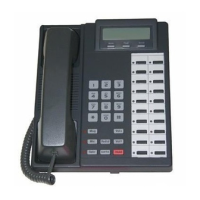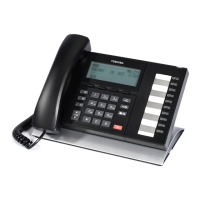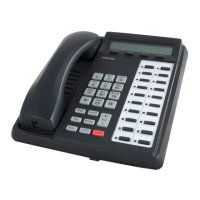Do you have a question about the Toshiba KM5020 and is the answer not in the manual?
Details connection means and radio frequency interference compliance.
Information about UL listing and secondary protection requirements.
Guidelines for repairing certified equipment and user responsibilities.
Warning about electrical ground connections and contacting authorities.
Licensing requirements for music-on-hold features.
FCC rules regarding hearing aid compatibility for business telephones.
Critical warning about IPedge/VIPedge system dependency on power and network for 911.
Warning about default credentials and system security.
Defines key terms used in the license agreement.
Outlines the terms and conditions for using the software.
Explains the necessity and function of a Software License Key.
Prohibits reverse engineering, modification, and unauthorized use.
Conditions under which the license automatically terminates.
States ownership and protection of intellectual property.
Details terms for using Open Source Software components.
Mitel's responsibilities and user's obligations regarding IP infringement.
Warranty on software performance and media defects.
Describes Mitel's remedies for warranty failures.
Situations that void the limited software warranties.
User's responsibility for software selection, installation, and results.
Explicit disclaimer of all other warranties beyond limited ones.
Prohibition of software use in hazardous environments.
Clarification regarding statutory rights and limitations.
Disclaimer regarding software immunity to intrusion or malware.
Limitations on Mitel's liability for various losses.
Caps Mitel's aggregate liability to license fees paid.
User's obligation to comply with export laws.
Terms for U.S. Government use of software and documentation.
How to obtain technical support for the software.
Defines the complete agreement, governing law, and data collection.
Covers installation of IP5000-series IP Telephones on IPedge/VIPedge.
Provides critical advice for handset cord and general installation.
Details IPedge and VIPedge support for IP5000-series telephones.
Lists IP5000 series IP Telephone models and their descriptions.
Specifies the IP End point License requirements for IPedge/VIPedge.
Explains that key labels are programmable via Enterprise Manager.
Provides temperature and humidity ranges for storage and operation.
Details the three tilt positions and additional tilt stand extension.
Explains power sources (local supply, PoE) and cable requirements.
Warning about the correct procedure for powering up via PoE.
Warning about the correct procedure for powering up via AC adapter.
Identifies connector icons and their meanings.
Steps for attaching and connecting Add-On Modules (ADM) to telephones.
Warning about unplugging cables before attaching ADM.
Describes the telephone initialization and connection sequence to IPedge.
Steps for connecting and programming IPedge stations.
Steps for connecting and programming VIPedge stations.
Note regarding serial numbers required for VIPedge system connection.
Adjusts when the backlight comes on and how long it stays lit.
Instructions for changing backlight settings on most IP5000 models.
Instructions for changing backlight settings on the IP5131 model.
Adjusts the LCD back light brightness on specific models.
Details how to adjust LCD contrast on telephones and ADMs.
Explains the function of the Mic/Mute key.
Procedure to reset four-line display phones to default settings.
Procedure to reset nine-line display phones to default settings.
Changing headset transmit sensitivity on four-line phones.
Changing headset transmit sensitivity on nine-line phones.
Explains the Analog Central Office (ACO) key and its use.
Details the characteristics of the CO Line accessed via the ACO key.
Describes the fourth initialization option (FB04) for ACO Default.
How the CO Line is accessed and its function as a single-line phone.
How to set headset transmit levels for ACO and IPT operation.
Explains the function of the BESCB1A amplifier.
How the loud ringing bell option amplifies voice or ringing signals.
Lists speaker impedance and power requirements for the BESCB1A output.
Explains using the HESC1A-65 cable to connect BESCB1A to telephone.
Using BESCB1A as an external loud ringer for an IPT telephone.
Specifies the required IP telephone software versions.
Details license requirements for IPedge system stations.
Details license requirements for VIPedge system telephones.
Allows creating stations beyond license limits for survivability.
Instructions for adding a new station via the Station Assignment interface.
Instructions for editing an existing station's configuration.
How to change the Primary Directory Number for a station.
Instructions for removing a station from the system.
Procedure for creating multiple Directory Numbers at once.
How to export station assignment data in CSV format.
How to import station assignment data from a CSV file.
Configuration for IPedge network DN information for other nodes.
Feature enabling survivability for stations in IPedge/VIPedge.
Details the eight tabs for station configuration.
Enter an existing PDN or create a new one for a station.
Select the type of station (IPT, SIP, Attendant, VM, ACD, SIP VM).
Sets the name displayed on the phone during idle and calls.
Enter CLID for external calls, displayed as Caller ID.
Allocate number of station speed dial bins (0-100).
Enable or disable setting System Speed Dial numbers.
VM MW Center Port
Configure system call forward group numbers (0-48).
Automatically create a mailbox when station assignment is saved.
Voice Mail box that answers when station calls VM or is forwarded.
Sets the password for the voice mail box.
Assign Personal Administration Role (EMPA, Phone User).
Class of Service for Day 1 mode (1-32).
Class of Service for Day 2 mode (1-32).
Class of Service for Night mode (1-32).
Destination Restriction Level for Day 1 mode (1-16).
Destination Restriction Level for Day 2 mode (1-16).
Destination Restriction Level for Night mode (1-16).
Facilities Restriction Level for Day 1 mode (1-16).
Facilities Restriction Level for Day 2 mode (1-16).
Facilities Restriction Level for Night mode (1-16).
Queuing Restriction Level for Day 1 mode (1-16).
Queuing Restriction Level for Day 2 mode (1-16).
Queuing Restriction Level for Night mode (1-16).
Least Cost Routing Group Number (1-16).
Sets the tone heard after dialing an LCR access code.
Station privilege to activate Call Pickup.
ISDN Bearer Capability for non-ISDN stations.
Controls what is displayed on the LCD for calling/called parties.
E911 Calling Party Information identifier.
Assigns the station to an emergency call group.
Password to remotely set/cancel DND or Call Forward.
Privilege to change Traveling Class of Service Override Code.
Trunk Group Access Code Override for attendant console.
Enables/disables beep tones for incoming calls.
Enables display of user name in the direct dial directory.
Network Class Of Service number for IPedge Net calls.
Automatic OCA for calls to busy stations.
Privilege to make OCA calls to other stations.
Controls how parked line calls appear on other stations.
Enables stuttered dial tone for message waiting, busy tone for DND.
Allows station-to-station message waiting activation.
Assigns the PDN to a tenant number (1-8).
Allows auto-campon to PDN when busy on a CO line.
Number of digits for sending LCR PDN code.
Enable or disable Speaker OCA on an IP telephone.
Determines if a password is required for phone login.
Sets the EMPA password and IP Mobility password (16 chars max).
Enables/disables logging out/into other IPT/SoftIPT locations.
Controls display of Station Name vs. DN for internal calls.
Enable or disable System Speed Dial supplement for IP stations.
Allows SIP extensions to transmit DTMF signals during ringing.
Sets maximum channels for a SIP station extension.
Assigns Class of Service to stations.
Accesses the Destination Restriction Wizard.
Accesses the Least Cost Routing Wizard.
Sets time for parked calls before signalling.
Lists access codes for call parking features.
Supports up to three DSS units and assigning Equipment Numbers.
Assigns functions to programmable feature buttons on telephones.
Copies key assignments to other stations or servers.
Sets timers for the station.
Sets up a Ring Down station and emergency ring down timer.
Sets up network parameters for a DN.
Assigns a fixed IP address or uses DHCP.
Enters the IP address if Type is set to Fix.
Automates Station ID assignment based on system settings.
Reserves PDN for IPT, enables MAC address authentication.
Sets the duration of DTMF tones sent from an IPT.
Displays the MAC address of the station.
Assigns tables for G.711 and G.729A codecs.
Displays the software version number of the IPT.
Sets the Uniform Resource Identifier for the SIP terminal.
Sets password for terminal authentication of the SIP terminal.
Sets connection mode to Media Relay Server for port forwarding.
Selects the audio codec (G.711, G.729A) for the IP telephone.
Resolves differing audio codec settings for peer-to-peer connections.
Sets the base UDP port for the IP telephone media channel.
Assigns DN to Call Pickup or Paging Group.
Assigns Phone Display Language and EMPA Language.
Displays a list of Phantom DNs and their assignments.
Setting the IP address for the telephone.
The mode where the IPT contacts the VIPedge/IPedge server.
Indicates the IPT is not programmed into a VIPedge database.
The IPT will change to on-premise mode and restart.
The IPT is not programmed into a VIPedge database.
The IPT starts looking for an IPedge server after initialization.
Prompt to enter the Directory Number for the station.
The IPT saves the IP address of the IPedge server.
The IPT registers to the IPedge server and becomes ready.
Displays status if the server is not found or busy.
Phone connects in Make Busy mode then changes to ready.
| Speakerphone | Yes |
|---|---|
| Headset Jack | Yes |
| Wall Mountable | Yes |
| Power over Ethernet (PoE) | Yes |
| Supported Protocols | SIP |
| Display | LCD |
| Ethernet Ports | 2 |











